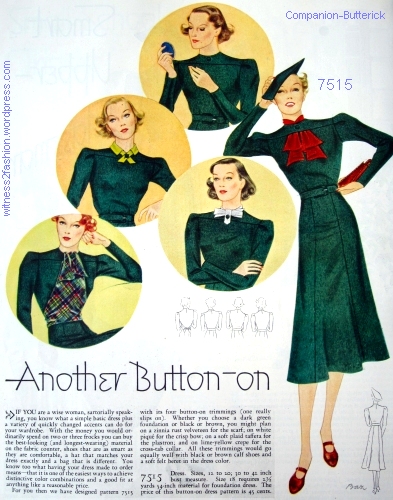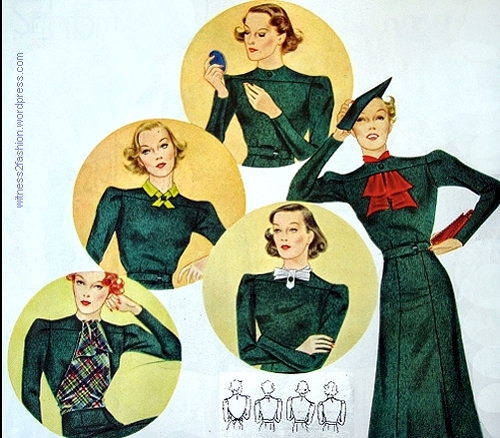I confess that I am fascinated by the many “button-on” patterns I’m finding in 1930s magazines. They reflect a completely different way of thinking about clothes than we have today, in our “cheap and disposable” clothing culture. As a teenager, I lived in a house built in 1908; it had 12 foot ceilings and leaded glass windows in the china cabinet doors, but the bedroom closets — one to a room — were three feet wide and barely one coat hanger deep. I am sometimes appalled by the “House Hunters” who demand two walk-in closets. Does anyone really need that much stuff? The average 1930s wardrobe for women would have fit in a very small closet.
Depression-Era Budget Savers
Although Butterick patterns were historically more expensive than Simplicity, DuBarry, and Hollywood patterns (and were aimed at middle to upper middle-class women) Companion-Butterick patterns often tried to give real value for money by emphasizing the versatility of their designs. (For more about Companion Butterick Triad patterns, click here .) [You can see more 1930s ideas for giving one dress many looks in my post “One Good Dress in the 1930s.” Click here. Edited 11/22/14 to add link.]
Companion-Butterick Pattern 7255
In March of 1937, this button-on dress, # 7255, was designed “to give you six day-time dresses at practically the price of one.”

Companion-Butterick pattern 7255, Woman’s Home Companion, March 1937. Available in sizes 12 to 20 and bust 30 to 44;” this pattern cost 45 cents.
“The various trimmings which make this miracle possible can be buttoned or slipped into the foundation dress with lightning speed. Suppose you make 7255 in brighter-than-navy crepe. Then you may like the look of a sturdy white pique vestee on Monday; of linden-green linen at neckline and belt on Tuesday; of sober scallops of the dress material on Wednesday; of crisp plaid taffeta on Thursday; of pink Bengaline on Friday; of the grand climax of embroidered batiste and cerise red velvet bow on Saturday. One pair of blue shoes and one blue bag … may serve with all these trimmings.”
There is a copy of this pattern in the Commercial Pattern Archive.
The comment that you would need ony one pair of shoes for all six looks reminds us that, in the 1930s, most women had to pinch every penny. Click here for Living on $18 per Week, which explains that a college girl or office worker was expected to buy no more than four dresses and four pairs of shoes each year.
Companion-Butterick Pattern 7515
In August of 1937, the pattern at the top of this post appeared. Here are some enlarged views:




 I’d be curious to see the construction of this dress, since the last two views show that there has to be a fairly large opening between the yoke and the bodice. I’m guessing there was some sort of tab or underlap on the bodice section which held the single, large button which fastened through a buttonhole on the yoke.
I’d be curious to see the construction of this dress, since the last two views show that there has to be a fairly large opening between the yoke and the bodice. I’m guessing there was some sort of tab or underlap on the bodice section which held the single, large button which fastened through a buttonhole on the yoke.
Companion-Butterick 7579
In October of 1937 another button-on frock appeared; number 7579 also suggested plaid taffeta or self-fabric for the office, with a gold lame vestee for “after-hour parties.”

Companion-Butterick pattern 7579, Woman’s Home Companion, October 1937, was suggested for both secretaries’ and debutantes’ wardrobes.
“For years some of the Companion’s most successful designs have been dresses with a series of easily buttoned-on trimmings, each planned to give the dress a different look. And now this ever-practical idea has become a real fashion fad, made by the smartest dressmakers, worn by the smartest women.”
Companion-Butterick Pattern 8597
This rather similar version — also with a plaid option — appeared two years later, in October 1939:
 All those buttons give a slightly military or western frontier look to pattern 8597.
All those buttons give a slightly military or western frontier look to pattern 8597.
Butterick 5948
The button-on idea was still around in 1951, when Butterick offered this convertible “round the clock dress” for days when you want to go from the office to a date:
“It’s covered up for daytime . . . decollete for date-time.” The sparkly buttons can be made “of jet, rhinestone, mock-pearl, or tortoise-shell so that, with the yoke off, the buttons become a decorative ‘jewelry’ accent.”
Suggested fabrics were faille, crepe, corduroy, or velveteen. Available sizes 12 to 20 and up to bust size 38 inches. I can imagine this design also being popular with women who dressed up to play bridge one afternoon a week, or who couldn’t justify the expense of a rarely worn cocktail dress. Many faille or taffeta afternoon or “bridge” dresses turn up on vintage racks.






How interesting that the style continued into the fifties, which was an economic boom era. It just shows that Butterick had its eye on those who were not so well off. If I made that fifties dress with the buttons, I can guarantee that the ad on would not fit so smoothly.
I love this idea! I especially love Butterick 7579! *swoon*
I never saw something like this (and I never searched for it, will be a completely new way to look through my patterns), but it is such a great idea. Amazing how versatile some of the styles are. Thanks very much for sharing these!
Not to forget that the dress would have been worn with a fresh petticoat and have under arm protector pads stitched in each day and switched out and washed to keep things sweet as well.
Absolutely true — for fastidious women. I think vintage dealers wish every woman had used Kleinert’s underarm protectors every day. Once antiperspirants became popular, many women stopped using “pit pads” — and ruined their dresses with a built-up chemical deposit as well as perspiration. Costumers still use Kleinert’s on non-washable costumes. We sew snaps on the the costume and the pads and switch them out daily. In a pinch, I have used a self-adhesive panti-liner trimmed to the shape of the dress’s underarm curve: Handy for sleeveless costumes.
Pingback: One Suit with Many Blouses: March 1936 | witness2fashion
Pingback: A Woman’s Clothing Budget for 1924 versus 1936 | witness2fashion
Pingback: Chin-Chokers, Accessories to Knit or Crochet, 1930s | witness2fashion
Pingback: More Blouses from the Early 1930’s | witness2fashion
Pingback: Also Very Thirties: Great Big Collars | witness2fashion